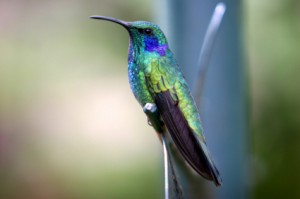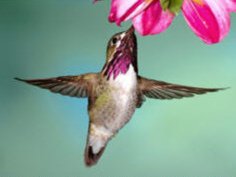The Reddish Hermit is a species of bird in the hummingbird family. The Reddish Hermit is one of the smallest hermit hummingbirds, at only 7.5 cm in length and it weighs about as much as a fly. This hummingbird’s habitats are primarily humid nature and include forest and woodlands. The Reddish Hermit is found in Bolivia, Brazil, Colombia, Ecuador, Peru, Venezuela, and the Guyana’s.
Category: Hummingbirds

The Green Violet Eared Hummingbird can be found at elevations as high as 13,000 feet. This is a tropical species of hummingbird which is known to breed from Mexico south to Bolivia.
Here is a fact about the Green Violet Eared Hummingbird that you will most likely find quite surprising. I know this information was completely unexpected to me. There have been two to documented occurrences of the Green Violet Eared Hummingbird in the North Carolina mountains. One took place in Asheville in late October of 1987. The other occurred in Burnsville in September of 1995.
The factual information for this post came from the North Carolina Museum of Natural Sciences. I wish to give proper credit for this information.
How Does a Hummingbird Groom Itself?
Every animal wants to look its best when trying to attract a mate or maybe the animal just wishes to clean itself. The hummingbird is no different and wishes to groom every part of its body. Have you ever wondered how a hummingbird goes about grooming itself? The answer will depend largely on what part of its body the hummingbird wants to groom. This post will explain how the hummingbird grooms itself.
The hummingbird’s bill and claws are the tools it uses to groom its self. The “cleaning agent” (for lack of a better term) the bird uses to accomplish the task of cleaning itself is oil from a gland near their tail. The hummingbird will groom their wings, abdomen, tail feathers and back. When the hummingbird wants to groom its head and neck, the bird will do so by using its front three claws like a comb. When a hummingbird wishes to groom their beak or neck, the hummingbird will do so by rubbing them against a twig.
Even in the animal kingdom, grooming is an important task and each animal has their own unique method of accomplishing this task. My desire is that this post has helped you better understand how hummingbirds accomplish this task.
Yes, hummingbirds do feed frequently, but hummingbirds also have a need for perches on feeders and in in your hummingbird garden. This post will explain what all can act as these perches and why it is important why your hummingbird garden provide this to the hummingbirds that visit your garden.
Hummingbirds look for perches on which to rest and preen whenever they are not feeding. These perches can be in the form thin vines, trellises, wires, clotheslines, or even multiple levels of vegetation that will also provide a source of shelter for the hummingbirds. Due to their extremely aggressive nature, the perches should also provide a good view of the hummingbird’s territory. If you have plants and shrubs on which the hummingbirds will perch, these should be placed near food sources which are known to attract hummingbirds to ensure the best possible success with attracting the hummingbirds.
As I sit here writing this post, I cannot help but think of my mom. You see, my mom did many things to attract the hummingbirds to our yard, but I cannot recall that she did anything except providing feeders with perches to give the hummingbirds a place to perch. As a result, I feel certain that she would have benefited from the information contained in this post to have helped her towards an even greater success with attracting hummingbirds to our yard. It is my hope that you will also benefit from the information contained in this post as well.
If you have been watching hummingbirds for any length of time, you have probably noticed that hummingbirds will commonly chase other hummingbirds away from plants or feeders. Do you know why they do this? This post will help give you a better understanding of the territorial nature of hummingbirds.
Male hummingbirds are very territorial for several reasons. The male is trying to defend his feeding territory. The male hummingbird does not want his territory to overlap with other male hummingbirds. A male hummingbird will defend his territory aggressively by doing a bluffing charge attack or he will engage the rival in a physical battle.
Another reason a male hummingbird is so fiercely protective of his territory is due to the desire to attract a mate. Before a female hummingbird agrees to mate with the male she is not allow in the territory and will be driven away from there. Once the female agrees to mate, she is given a”free pass” into the territory. This is extremely important to the female hummingbird because when she is sitting on her eggs or chicks she needs easy access to a nearby food source so she is not gone for too long or the offspring may die.
Do you know what size a territory a male hummingbird can defend? The answer may surprise you as it did me. A male hummingbird can defend a territory that is a quarter-acre or so. If the area contains nectar rich plants and plenty of well maintained feeders, a hummingbird will not have to leave his territory to search for food.
A female hummingbird will defend her nesting territory. The female hummingbird will forage for food up to half a mile in any direction from her nest.
If you wish to decrease the territorial battles among male hummingbirds, try these things. Hang multiple feeders so that there are more feeders for all the birds and maybe the birds will not feel the need to defend the feeder as strongly because there is other feeders from which to choose. Also, it may help if you hang your feeders at different heights.
Yes indeed, hummingbirds are extremely territorial in nature, but there are reasons for this. Many people may even think of hummingbirds as being “antisocial” but this is not the case. There are specific reasons why hummingbirds are territorial in nature and it is my hope that this post has helped you understand this better.
